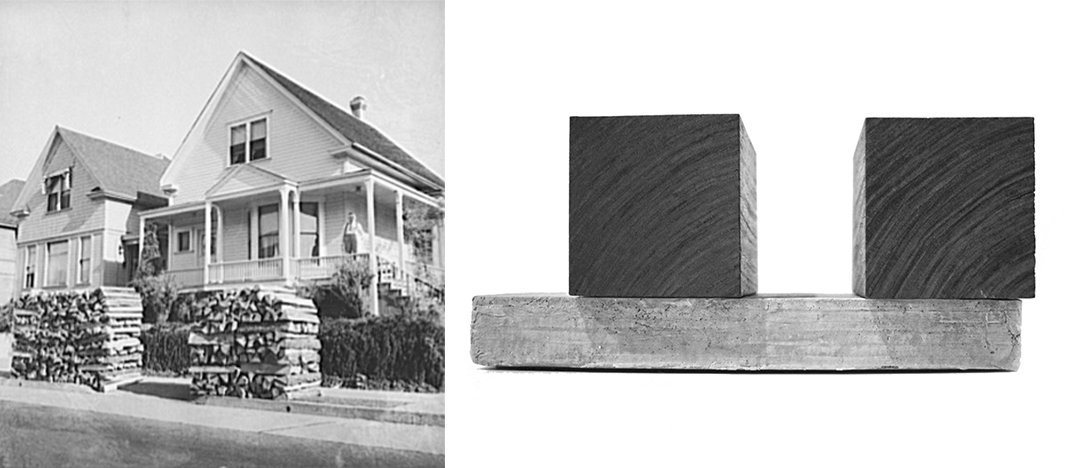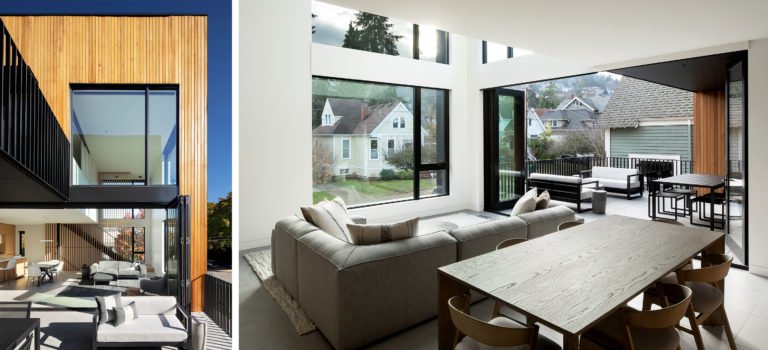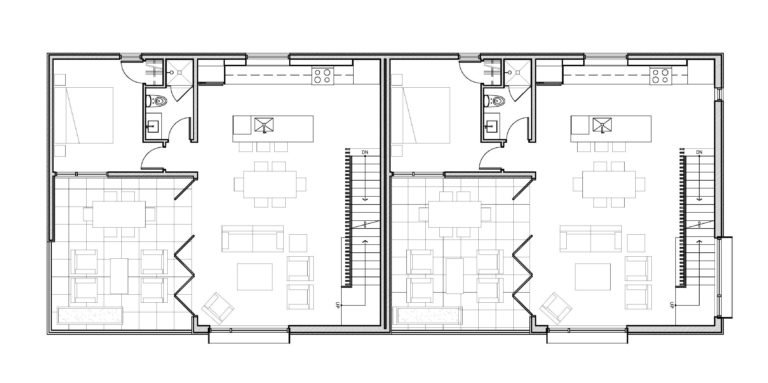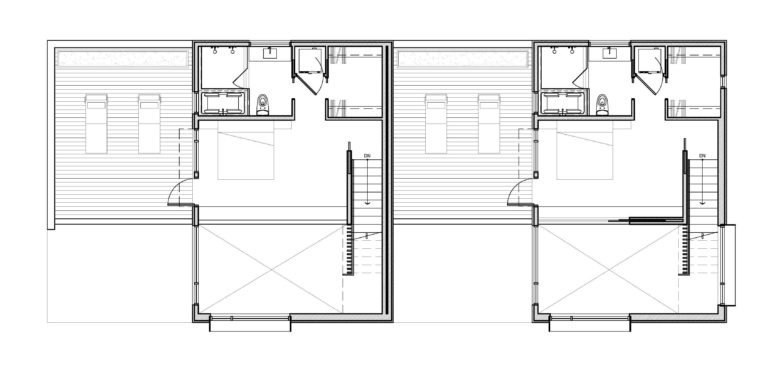Slabtown 4: A Model for Urban Infill
Author
Ryan Yoshida
Many cities around the U.S., Portland among them, are encouraging increased density in the urban core. The once-radical goal of the walkable neighborhood–with homes, workplaces, shops, and restaurants all within a 15-minute walking radius–has become mainstream. At the same time, an aging population is looking for housing solutions that allow them to remain in their homes, close to friends, family, and amenities. “Infill” housing development seeks to provide a variety of housing types in locations where urban amenities and infrastructure already exist, while the 15-minute neighborhood enables a more active, less car-dependent lifestyle for residents of any age.
Slabtown 4, located in Portland’s Northwest neighborhood, is a four-unit residence that addresses the challenges of both urban infill and innovative, multi-generational housing. In 2017, the homeowners presented partner Rick Berry and team with the challenge of designing two single-family townhouse units and two accessory dwelling units (ADUs), each with outdoor spaces and parking, all on a tight urban lot. Three of the four units would be for family members, with the fourth as an office or to provide additional income as a rental. Since one of the goals of the project was to enable family members to age in place, it was important to provide both proximity and privacy: gathering spaces that would allow the whole family to come together, and private spaces that would allow everyone to live independent lives.
“A special moment of this project came when we got to meet the client, grandparents, brother, sister, and grandchildren, who all wanted to live in one complex with separate units. This close-knit family was an inspiration to the design team and helped create a bold yet timeless structure that integrated elegantly into the urban context.”
The site consisted of two lots at the corner of NW 24th and Savier, one a slim 1,725 sf and the other 3,850 sf. The site is in a transitional zone, where the neighborhood begins to shift from the Alphabet District’s mix of housing and pedestrian-oriented retail towards commercial and high-density multi-dwelling uses. The area’s zoning designation calls for low-density multi-dwelling development, intended to provide a transition from the adjacent commercial zoning to single-dwelling residential scale. A recent zoning change expanded the types of housing allowable in the area, with the aim of providing more flexibility while maintaining a character compatible with Portland’s residential neighborhoods.
The homeowners’ dream for a multi-generational home for their family was a great fit for the City of Portland’s goals for the new zoning designation. The clients wanted separate spaces for family members, with a single-family residential “feel,” but they also wanted to build on a scale large enough to create a holistic integration of the four dwelling units. Their location on a corner lot with traditional 1900’s homes to the west and commercial buildings and warehouses to the east, was the perfect place to introduce something new and marry the different scales of the surrounding neighborhood.
“Because we were planning on living in this house for decades to come, our initial guidance to Rick Berry was that we wanted to be respectful of the neighborhood. When we saw the creative design, the great use of materials, and the thoughtful setbacks, we knew that he heard us and that we had chosen wisely.”
Inspiration for the form came straight from the area’s early history. In the late nineteenth century, the neighborhood adopted the name Slabtown when a lumber mill opened on Northrup Street. The mill’s discarded log edges or “slabwood” were stacked in piles on sidewalks for residents to use as heat and cooking fuel. The two wooden volumes for the single-family townhouse units, sitting on a solid base containing the ADUs, echo these stacks of slabwood. These two-story wooden volumes are similar in shape, scale, and material to the traditional homes of the neighborhood, while the base grounds the structure, breaks up the verticality, and speaks to the nearby one-story commercial and industrial buildings. The ground level plan engages the streetscape with entries and an outdoor patio, while feeling modern and monolithic to provide a sense of security and privacy for the occupants. A dark manganese iron spot brick was paired with matching grout and raked joints—adding texture to the façade with a material that complements the surrounding context. The ADUs both have outdoor patios and the two-story townhouse units have private roof decks with views to the west hills and the city of Portland.
Aging in Place
Because one of the project’s goals was to allow family members to age in place, it was important to avoid stairs or other barriers in the ADUs. This meant that the traditional strategies of locating the smaller units above a garage or in a daylight basement would not work. Instead, the ADUs are located on the ground floor, wrapping around the garages to provide daylight on at least two sides of each unit and the same easy flow between indoor and outdoor spaces as the townhouse units have.
ADU and Townhouse entry floor plans
Interior Quality
The interior is clean, modern, and minimal with a slight Japanese influence. The palette includes natural materials, white surfaces flooded with daylight, black metal accents, and modern white oak cabinetry. The townhouse units feature double-height living spaces with loft-style main bedrooms to keep the interior bright, open, and airy. A two-story vertical screen wall of white oak slats adds texture to the space while preserving some transparency and acting as the guardrail for the stairs.
Since maintaining a connection to the outdoors is important when the main living area is on the upper floor, large folding doors were used to make the transition to the outside seamless, allowing the living room to double in size for entertaining with an easy flow to the adjacent roof deck. An indoor/outdoor floor tile creates a continuous floor surface between the two spaces. The third-floor bedroom suites have direct access to the upper roof deck, which is clad with wood to provide a soft, warm surface for yoga and bare feet.
Learn more
Contractor: iBuildPdx
Landscape Design: Shapiro/Didway
Lighting Design: O-
More on the Slabtown 4 project page.
The result is a project that honors the family’s wish to create four homes in a highly walkable and vibrant neighborhood, while continuing a larger conversation about density and urban infill in Portland. Portland zoning is increasing and encouraging density in most neighborhoods; Slabtown 4 is a great example of prioritizing neighborhood scale and creating quality indoor and outdoor spaces in the process.










